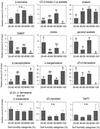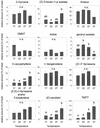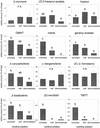The effects of abiotic factors on induced volatile emissions in corn plants
- PMID: 12114583
- PMCID: PMC166523
- DOI: 10.1104/pp.001941
The effects of abiotic factors on induced volatile emissions in corn plants
Abstract
Many plants respond to herbivory by releasing a specific blend of volatiles that is attractive to natural enemies of the herbivores. In corn (Zea mays), this induced odor blend is mainly composed of terpenoids and indole. The induced signal varies with plant species and genotype, but little is known about the variation due to abiotic factors. Here, we tested the effect of soil humidity, air humidity, temperature, light, and fertilization rate on the emission of induced volatiles in young corn plants. Each factor was tested separately under constant conditions for the other factors. Plants released more when standing in dry soil than in wet soil, whereas for air humidity, the optimal release was found at around 60% relative humidity. Temperatures between 22 degrees C and 27 degrees C led to a higher emission than lower or higher temperatures. Light intensity had a dramatic effect. The emission of volatiles did not occur in the dark and increased steadily with an increase in the light intensity. An experiment with an unnatural light-dark cycle showed that the release was fully photophase dependent. Fertilization also had a strong positive effect; the emission of volatiles was minimal when plants were grown under low nutrition, even when results were corrected for plant biomass. Changes in all abiotic factors caused small but significant changes in the relative ratios among the different compounds (quality) in the induced odor blends, except for air humidity. Hence, climatic conditions and nutrient availability can be important factors in determining the intensity and variability in the release of induced plant volatiles.
Figures











Similar articles
-
Volatile interaction between undamaged plants affects tritrophic interactions through changed plant volatile emission.Plant Signal Behav. 2014;9(8):e29517. doi: 10.4161/psb.29517. Plant Signal Behav. 2014. PMID: 25763628 Free PMC article.
-
Quantitative relationships between induced jasmonic acid levels and volatile emission in Zea mays during Spodoptera exigua herbivory.Planta. 2003 Feb;216(4):665-73. doi: 10.1007/s00425-002-0898-y. Epub 2002 Sep 11. Planta. 2003. PMID: 12569409
-
Dispensing synthetic green leaf volatiles in maize fields increases the release of sesquiterpenes by the plants, but has little effect on the attraction of pest and beneficial insects.Phytochemistry. 2011 Oct;72(14-15):1838-47. doi: 10.1016/j.phytochem.2011.04.022. Epub 2011 Jun 12. Phytochemistry. 2011. PMID: 21658734
-
Effects of Abiotic Factors on HIPV-Mediated Interactions between Plants and Parasitoids.Biomed Res Int. 2015;2015:342982. doi: 10.1155/2015/342982. Epub 2015 Dec 15. Biomed Res Int. 2015. PMID: 26788501 Free PMC article. Review.
-
Protective perfumes: the role of vegetative volatiles in plant defense against herbivores.Curr Opin Plant Biol. 2009 Aug;12(4):479-85. doi: 10.1016/j.pbi.2009.04.001. Epub 2009 May 19. Curr Opin Plant Biol. 2009. PMID: 19467919 Review.
Cited by
-
Canopy light cues affect emission of constitutive and methyl jasmonate-induced volatile organic compounds in Arabidopsis thaliana.New Phytol. 2013 Nov;200(3):861-874. doi: 10.1111/nph.12407. Epub 2013 Jul 12. New Phytol. 2013. PMID: 23845065 Free PMC article.
-
Belowground Ecology of Scarabs Feeding on Grass Roots: Current Knowledge and Future Directions for Management in Australasia.Front Plant Sci. 2016 Mar 22;7:321. doi: 10.3389/fpls.2016.00321. eCollection 2016. Front Plant Sci. 2016. PMID: 27047506 Free PMC article. Review.
-
Localization of sesquiterpene formation and emission in maize leaves after herbivore damage.BMC Plant Biol. 2013 Jan 30;13:15. doi: 10.1186/1471-2229-13-15. BMC Plant Biol. 2013. PMID: 23363415 Free PMC article.
-
The defensive role of volatile emission and extrafloral nectar secretion for lima bean in nature.J Chem Ecol. 2008 Jan;34(1):1-13. doi: 10.1007/s10886-007-9404-0. Epub 2007 Dec 12. J Chem Ecol. 2008. PMID: 18071821 Free PMC article.
-
Essential compounds in herbivore-induced plant volatiles that attract the predatory mite Neoseiulus womersleyi.J Chem Ecol. 2007 Sep;33(9):1670-81. doi: 10.1007/s10886-007-9344-8. Epub 2007 Sep 5. J Chem Ecol. 2007. PMID: 17786519
References
-
- Agelopoulos NG, Keller MA. Plant-natural enemy association in tritrophic system, Cotesia rubecula-Pieris rapae-Brassicaceae (Cruciferae): III. Collection and identification of plant and grass volatiles. J Chem Ecol. 1994;20:1955–1967. - PubMed
-
- Alborn HT, Turlings TCJ, Jones TH, Stenhagen G, Loughrin JH, Tumlinson JH. An elicitor of plant volatiles from beet armyworm oral secretion. Science. 1997;276:945–949.
-
- Altenburger R, Matile P. Further observation on rhythmic emission of fragrance in flowers. Planta. 1990;180:194–197. - PubMed
-
- De Moraes CM, Lewis WJ, Paré PW, Alborn HT, Tumlinson JH. Herbivore-infested plants selectively attract parasitoids. Nature. 1998;393:570–573.
-
- Dicke M. Why do plants “ talk” ? Chemoecology. 1994;5/6,3/4:159–165.
Publication types
MeSH terms
Substances
LinkOut - more resources
Full Text Sources
Other Literature Sources

